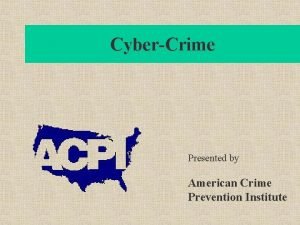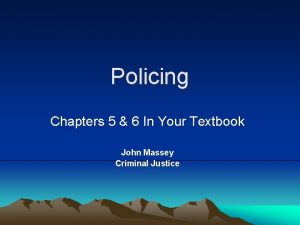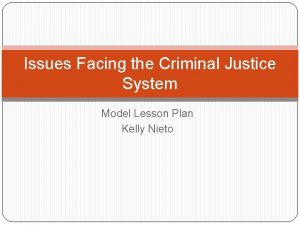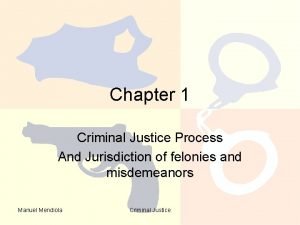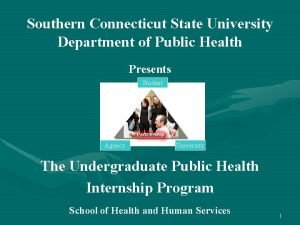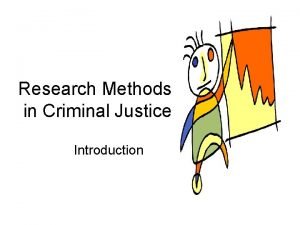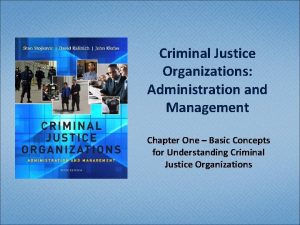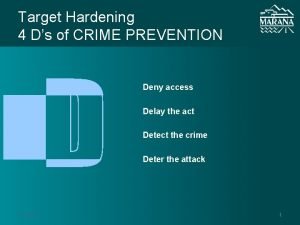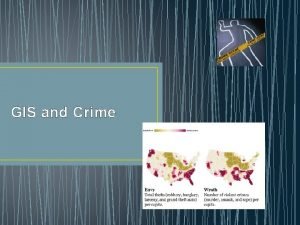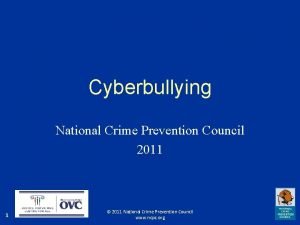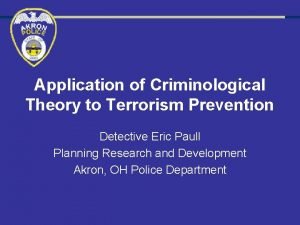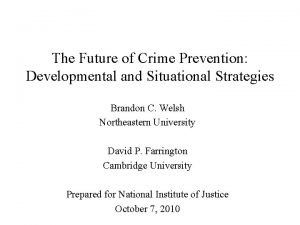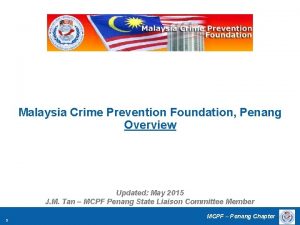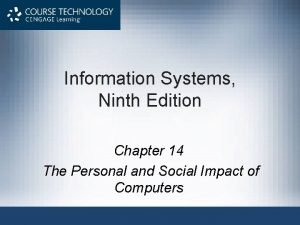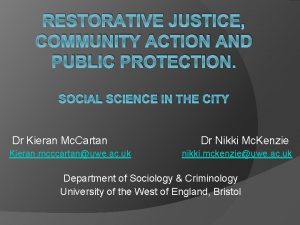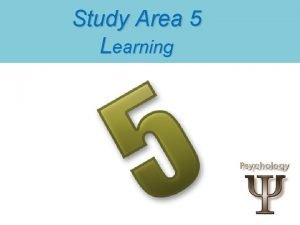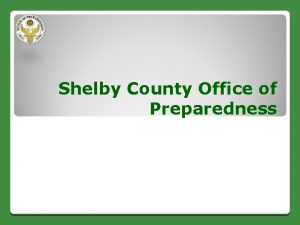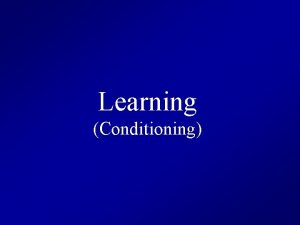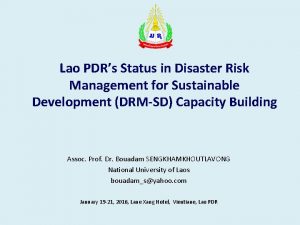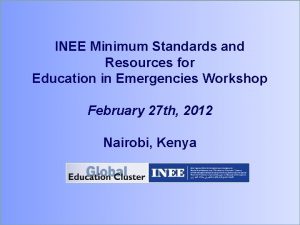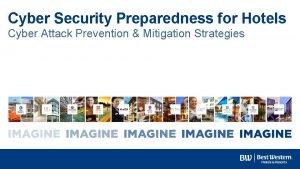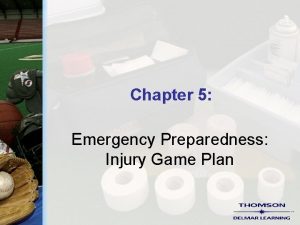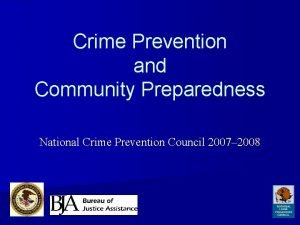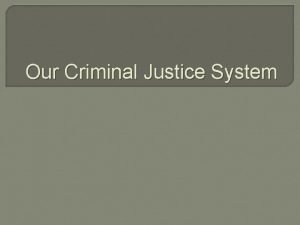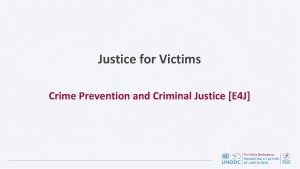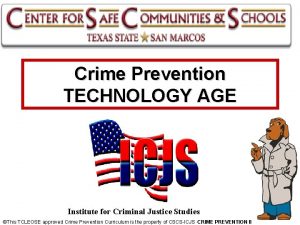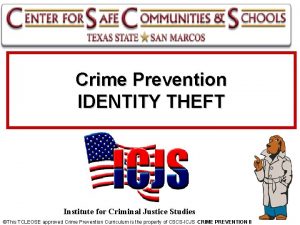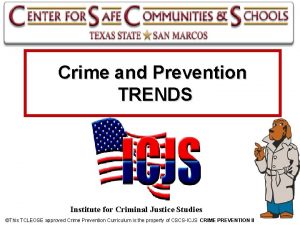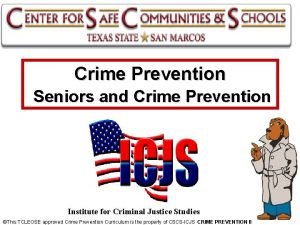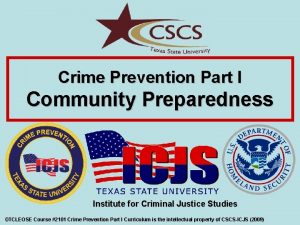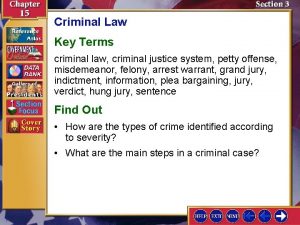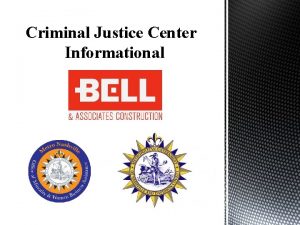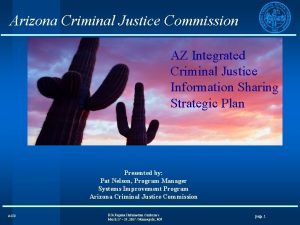Crime Prevention Community Preparedness Institute for Criminal Justice






























































- Slides: 62

Crime Prevention Community Preparedness Institute for Criminal Justice Studies ©This TCLEOSE approved Crime Prevention Curriculum is the property of CSCS-ICJS CRIME PREVENTION Part II (2008)

Objectives • Learning Objective: The participant will learn and demonstrate knowledge of the crime prevention framework. • Learning Objective: The participant will learn and demonstrate knowledge of Planning for community preparedness • Learning Objective: The participant will learn overview and demonstrate knowledge of homeland security • Learning Objective: The participant will learn and demonstrate knowledge of what individuals can do for community preparedness. • Learning Objective: The participant will learn and demonstrate knowledge and importance of the role of Citizen Corps programs and resources • Learning Objective: The participant will learn and demonstrate knowledge of how a community-based Neighborhood Watch can contribute to community preparedness

C r i m e P r e v e n ti o n A pattern of attitudes and behaviors directed both at reducing the threat of crime and enhancing the sense of security, to positively influence the quality of life in our society, and to develop environments where crime cannot flourish. Crime Prevention Coalition of America

The Ten Action Principles of Crime Prevention Crime prevention is. . . 1. 2. 3. Everyone’s business More than security A responsibility at all levels of government 4. Linked with solving social problems 5. Cost - effective

The Ten Action Principles of Crime Prevention Crime prevention requires. . 6. A central position in law enforcement 7. Cooperation among all elements of the community 8. Education and Training 9. Tailoring to local needs and conditions 10. Continual testing and

In Essence… Crime prevention improves the quality of life for every community

The Crime Prevention Framework • Crime prevention has a strategic role to play in community preparedness • Practitioners can help communities apply crime prevention skills to the work of community preparedness. • A safe nation begins with safe, engaged communities

Community Preparedness Much like crime prevention, everyone can have a role in preparing for the unexpected emergency. Individuals or families can prepare by… • Identifying meeting locations in case of an emergency • Developing a family emergency contact list • Assembling a disaster supplies kit • Taking a first aid or CPR course

Community Preparedness (continued) Selecting a Meeting Location • Most families are not together 24 hours a day; thus, planning ahead is important. • Location points should be commonly frequented or accessible locations. • Schools, Schools public spaces, or neighbors’ homes may be ideal Source: www. fema. gov locations to meet.

Community Preparedness (continued) An emergency contact list should include • • • Out-of-town family contacts Work phone numbers Neighbors’ phone numbers School phone numbers County and city emergency management phone numbers

Community Preparedness (continued) A family disaster plan should include • Two or more ways to stay in contact (e. g. email, phone, etc. ) • Escape routes from work or home and selected meeting location • Name and number of an out-of-state friend as a family contact

Community Preparedness (continued) A description of medical or health needs that will need attention (e. g. , diabetes, asthma, etc. ) • A stock of nonperishable emergency supplies and a first aid kit • A plan for what to do with pets • Training in first aid, CPR, and disaster preparedness

Community Preparedness (continued. ) Disaster Supply Kit • Water (1 gallon per • Toiletries day person for 3 to • Tools, Tools fuel, fuel duct tape, etc. 7 days) • Food (for 3 to 7 days) • Flashlight/batteries • Battery operated • Blankets/pillows Blankets radio • Clothing • Cash and identification • First aid kit People do not plan to fail; • Medicine they simply fail to plan.

Pandemics What is a Pandemic? A Pandemic is an epidemic (an outbreak of an infectious disease) that spreads worldwide, or at least across a large region.

According to the World Health Organization A pandemic can start when three conditions have been met: 1) the emergence of a disease new to the population 2) the agent infects humans, humans causing serious illness 3) the agent spreads easily and sustainably among humans

According to the World Health Organization - Continued • A disease or condition is not a pandemic merely because it is widespread or kills a large number of people; it must also be infectious Typhoid Fever Typhus Bubonic Plague Influenza Cholera Ebola Virus Small Pox SARS & HIV

Pandemic Preparedness (continued) Staying informed is the best preparation Identify sources you can rely on for accurate information Look for information on your local and state websites Talk to your local healthcare providers and public health officials

Pandemic Preparedness (cont. ) Services on all levels may be disrupted • Consider that hospitals, hospitals banks, banks government offices, etc. may not be available • Plan for possible public transportation cancellations and/or fuel shortages • Consider how to care for those with special needs if services are unavailable Remember Hurricane Rita & the elderly & handicapped

Pandemic Preparedness (cont. ) Employment – Income: Being able to work may be difficult or impossible • Ask your employer about plans to operate in the event of a pandemic • Plan for income loss if you are unable to work or your company closes • Check with your employer or union about leave policies for yourself and family

Pandemic Preparedness (cont. ) Schools and/or child care may be closed for an extended period • Talk with teachers - administrators about their plans to operate during a pandemic - consider child care arrangements • Plan home learning and exercise activities for children who may stay home

Pandemic Preparedness (cont. ) Staying Healthy- Medical facilities may be overwhelmed during a pandemic • Take steps to limit the spread of germs; wash your hands, cover your mouth, etc. • Stay at home if you are sick and avoid close contact with those who are sick • Don’t forget healthy habits: habits eat well, exercise regularly, and get plenty of rest • If you are on medications or are receiving ongoing treatment, treatment talk with your healthcare provider about access to medications and care during a pandemic

Overview of Homeland Security

More than half of American adults (55 percent) are worried about another major terrorist attack on the United States in the coming year. February 2004 Wirthlin Worldwide Report

Oklahoma City Bombing 1995

Only one in seven American adults (16 percent) believes that his or her community is extremely prepared or very prepared to respond to a terrorist attack. February 2004 Wirthlin Worldwide Report

Overview of Homeland Security • Prevent terrorist attacks within the United States • Reduce America’s vulnerability to terrorism • Minimize the damage and recover from attacks that do occur

Definitions of Terrorism Department of State: “Premeditated, politically motivated violence perpetrated against noncombatant targets by subnational groups or clandestine agents, usually intended to influence an audience. ”

Definitions of Terrorism Department of Defense: “The calculated use of violence or threat of violence in order to inculcate fear, fear intended to coerce or intimidate governments or societies in the pursuit of goals that are generally political, religious, or ideological. ”

Key Elements of Terrorism • Premeditated - planned in advance, rather than an impulsive act of rage • Use of extreme force and violence • Coercion of a government or population • Furtherance of a political or social objective • Carried out by subnational groups, groups not by the army of a country

International Terrorism Includes terrorist activity committed by groups or individuals that cross national boundaries. These boundaries can be both physical as well as cultural.

Domestic Terrorism Includes terrorist acts by groups or individuals who are U. S. citizens based entirely within the United States without foreign direction and whose terrorist acts are directed at elements of the U. S. government or society. Most well known was Oklahoma City Bombing

Potential Targets • Symbolic buildings and largely populated areas or events • Examples include schools, schools hospitals, airports, water supplies, government buildings, or symbols of Govt. , dams or rail lines.

Potential Terrorist Threats • Biological: Biological The deliberate release of germs or other substances that may be inhaled, enter through a cut in the skin, or be digested to make one sick. • Chemical: The deliberate release of a toxic gas, gas liquid, liquid or solid designed to poison people and the environment.

Potential Terrorist Threats (continued) • Nuclear: An explosion with intense light and heat, heat damaging pressure wave, wave and widespread radioactive materials that can contaminate air, water, and ground surfaces for miles around. • Radiation: Sometimes known as a “dirty bomb, ” bomb this weapon uses common explosives to spread radioactive materials over a targeted area.

Homeland Security Advisory System • This system was designed to provide comprehensive information on the risk of terrorist acts to federal, state, and local authorities. • The system warns of increased threat conditions that increase as the risk of threat increases.

Homeland Security Advisory System • Federal departments and agencies would implement a corresponding set of protective measures to reduce vulnerability or increase response capability during a heightened alert.

Homeland Security Advisory LOCAL RESPONSE alert status System – Local. As. Response INCREASES there is a greater need for specific public education about threats and safety measures. As alert status DECREASES, DECREASES there is a greater need for public dialogue, coalition development, community scanning, and dialogue. Copyright 2002 David Carter

Homeland Security Advisory System – Federal Response What do the colors mean to you?

Threat Conditions and Protective Measures Low Condition (Green) Department and Agencies Community Members • Refine and exercise prearranged • Develop a household protective measures. disaster plan. • Ensure personnel receive proper • Assemble a disaster training on the HSAS and supply kit. prearranged department/agency protective measures. • Create a process to assess all facilities and regulated sectors for vulnerability to attack and institute measures to reduce vulnerability.

Threat Conditions and Protective Measures Guarded Condition (Blue ) Department and Agencies • Check communications with designated emergency response or command locations. • Review and update emergency response procedures. • Provide public with appropriate information to strengthen protective measures. • • • Community Members Hold household meeting to review disaster plan. Update disaster supply kit. Develop a communications plan. Apartment residents should discuss emergency steps with building managers. People with special needs should discuss plans with friends and family.

Threat Conditions and Protective Measures Elevated Condition (Yellow) Department and Agencies • Increase surveillance of strategic/critical locations. • Coordinate emergency plans with appropriate jurisdictions. • Assess whether threat requires refinement of prearranged protective measures. • Implement appropriate contingency plans. • • Community Members Be observant; report any suspicious activity to authorities. Contact neighbors to discuss their plans or needs. Check with school officials to assess their emergency planning and procedures to reunite children with parents/caregivers. Update household communication plan.

Threat Conditions and Protective Measures High Condition (Orange) • • Community Members Department and Agencies • Review preparedness Coordinate security efforts with federal, state, and local law measures for response enforcement, National Guard, or to terrorist actions other security and armed forces. including chemical, Take additional precautions at biological, and public events, from moving to an radiological attacks. alternative site to cancellation. Prepare to implement • Avoid potential high-risk contingency procedures areas. including moving to an • Exercise caution when alternative site and dispersing workforce. traveling. Restrict access to threatened facility to essential personnel.

Threat Conditions and Protective Measures Severe Condition (Red) • • Department and Agencies Direct personnel to address critical emergency needs. Assign emergency response personnel; mobilize specially trained teams and resources. Monitor, redirect, or close transportation systems. Close nonessential public and government facilities. • • Community Members Avoid public gathering places, public gatherings, and other high-risk locations. Listen for and follow radio and TV advisories restricting activities. Contact employer regarding status of work. Prepare to take protective actions such as shelteringin-place or evacuation.

Desired Outcomes of Terrorist Activity • Cause an overreaction by the government • Recognition or publicity for the group • Harass or embarrass the government • Steal money or equipment • Destroy facilities or equipment • Free prisoners

Pre-incident Indicators and Warning Signs • History has shown that terrorist attacks do not occur in a vacuum. • Attacks are organized and planned weeks, months, and sometimes years in advance. • The planning stage is law enforcement’s best opportunity to prevent attacks.

Other Pre-incident Indicators • Persons observed near identified potential targets carrying video cameras or observation equipment with high-magnification lenses. • Individuals observed parking, standing, or loitering in the same area for multiple days. • Persons observed with maps, maps photos, diagrams or sketches of facilities.

Other Pre-Incident Indicators (continued) • A pattern or a series of false alarms requiring law enforcement and/or emergency response • Reported thefts of military, military law enforcement, enforcement or fire ID cards, license plates, uniforms etc. • Nonmilitary persons stopped with military - style weapons, weapons clothing, clothing and equipment

C r i m e P r e v e n ti o n and Community Preparedness Programs Work !

What Community Residents Can Do • Join or organize a local Block Watch or Neighborhood Watch with local authorities. • Obtain information from www. usaonwatch. com. • Get friends, friends family, family and neighbors involved.

What Community Residents Can Do (continued) • Stay informed and updated on the news. • Stay alert; alert be aware of your surroundings. • Practice observation techniques.

Programs and Resources Citizen Corps Councils Provide a mechanism for local citizen participation by coordinating Citizen Corps programs, developing community action plans, assessing possible threats, and identifying local resources. Website www. citizencorps. gov/ programs/

Programs and Resources Volunteers in Police Service (VIPS) Provides support for resource-constrained police departments by incorporating civilian volunteers so that law enforcement professionals have more time for frontline duty. Website www. policevolunteers. org

Programs and Resources Community Emergency. Website Response Team http: //training. fema. gov (CERT) Trains people in neighborhoods, the workplace, and schools in basic disaster response skills, such as fire suppression, urban search and rescue, and medical operations, and helps them take a more active role in emergency preparedness.

Programs and Resources Medical Reserve Corps (MRC) Coordinates volunteer health professionals, as well as other citizens with an interest in health issues, to provide ongoing support for community public health needs and resources during large-scale emergencies. Website www. medicalreserve corps. gov

Neighborhood Watch • Crime prevention group organized around a block, block defined neighborhood or business district • Serves as eyes and ears of law enforcement • Helps establish - reclaim informal control of an area by observation, visibility, increased social interaction

Neighborhood Watch (cont. ) • Time and resources donated • Usually no formal budget or funding source • Success results in reduction in crime, crime improved quality of life

The Benefits of Neighborhood Watch Studies show it is effective because • It brings neighbors together around a common cause – safety and security. • It provides basic skills to all members on preventing crime and reporting suspicious behavior or actual crimes. • It builds a base for correcting neighborhood problems. • It works well with other civic associations.

TEAM PRACTICAL EXCERCISE • TEAM I: Explain (overview) of community preparedness. • TEAM II: Explain (overview) of Pandemics • TEAM III: Explain (overview) of Homeland Security mission, goals and objectives. • TEAM IV: Explain Homeland Security Advisory System and Pre-incident indicators. • TEAM V: Explain what communities can do to prepare for Homeland Security Defense

RESOURCES • Federal Emergency Management Agency www. fema. gov • Environmental Protection Agency www. epa. gov • National Crime Prevention Council www. ncpc. org U. S. Department of Homeland Security www. dhs. gov/dhspublic • Neighborhood Watch www. usaonwatch. org • American Red Cross www. redcross. org • Business Health Services www. bhsonline. com World Health Organization www. who. int/en/

Sources • Citizens’ Preparedness Guide, National Crime Prevention Council, 2002 • Crime Prevention Can Spur and Support Homeland Security in Neighborhoods and Communities, National Crime Prevention Council, 2003 www. ncpc. org • National Criminal Justice Reference Service – www. ncjrs. gov

National Crime Prevention Council 1000 Connecticut Avenue, NW Thirteenth Floor Washington, DC 20036 -5325 202 -466 -6272 www. ncpc. org

Presenter Contact Information 350 N. Guadalupe, Suite 140, PMB 164 San Marcos, Texas 78666. 877 -304 -2727 www. cscs. txstate. edu
 Primary prevention secondary prevention tertiary prevention
Primary prevention secondary prevention tertiary prevention Crime prevention institute
Crime prevention institute Guelph cjpp
Guelph cjpp Criminal justice wedding cake
Criminal justice wedding cake Division of criminal justice ct
Division of criminal justice ct Wedding cake model of criminal justice examples
Wedding cake model of criminal justice examples What is a grass eater in criminal justice
What is a grass eater in criminal justice Criminal justice lesson
Criminal justice lesson Consensus model criminal justice
Consensus model criminal justice Consensus model criminal justice
Consensus model criminal justice Define corrections in criminal justice
Define corrections in criminal justice 4 pillars of justice
4 pillars of justice Consensus model criminal justice
Consensus model criminal justice Criminal typology
Criminal typology Consensus model criminal justice
Consensus model criminal justice Consensus model criminal justice
Consensus model criminal justice Consensus model criminal justice
Consensus model criminal justice Nonintervention perspective of criminal justice
Nonintervention perspective of criminal justice Criminal law and juvenile justice unit 2
Criminal law and juvenile justice unit 2 Wedding cake criminal justice model
Wedding cake criminal justice model Arizona criminal justice information system
Arizona criminal justice information system Responsibilities of saps in the criminal justice system
Responsibilities of saps in the criminal justice system Department of criminal justice services ny
Department of criminal justice services ny National archive of criminal justice data
National archive of criminal justice data Criminal justice wedding cake diagram
Criminal justice wedding cake diagram Criminal justice
Criminal justice Types of intermediate sanctions
Types of intermediate sanctions Conflict theory criminal justice
Conflict theory criminal justice Data analysis in criminal justice
Data analysis in criminal justice The american system of criminal justice 16th edition
The american system of criminal justice 16th edition Mexico criminal justice system
Mexico criminal justice system Southern connecticut state university criminal justice
Southern connecticut state university criminal justice Inaccurate observation in criminal justice
Inaccurate observation in criminal justice Ocjs grants
Ocjs grants Jmu criminal justice minor
Jmu criminal justice minor Everyday ethics for the criminal justice professional
Everyday ethics for the criminal justice professional Management in criminal justice organizations
Management in criminal justice organizations Murder suicide moorpark
Murder suicide moorpark Match the crimes to their definitions
Match the crimes to their definitions 4 ds of security
4 ds of security Uses of gis in crime prevention
Uses of gis in crime prevention National crime prevention council cyberbullying
National crime prevention council cyberbullying Situational crime prevention definition
Situational crime prevention definition Ron clarke 1992
Ron clarke 1992 Saps sandton
Saps sandton Developmental crime prevention
Developmental crime prevention 25 situational crime prevention techniques
25 situational crime prevention techniques Malaysia crime prevention foundation
Malaysia crime prevention foundation Crime prevention 9th edition
Crime prevention 9th edition Cyber crime prevention luxembourg
Cyber crime prevention luxembourg Social justice and community action
Social justice and community action Chandru lawyer caste
Chandru lawyer caste Biological preparedness
Biological preparedness Shelby county office of preparedness
Shelby county office of preparedness Insight learning theory
Insight learning theory Conditioning learning
Conditioning learning Conclusion in disaster management
Conclusion in disaster management Preparedness mitigation response recovery
Preparedness mitigation response recovery Biological preparedness
Biological preparedness Promoting family earthquake preparedness
Promoting family earthquake preparedness Hotel cyber security
Hotel cyber security Biological preparedness
Biological preparedness Chapter 5 emergency preparedness injury game plan
Chapter 5 emergency preparedness injury game plan

